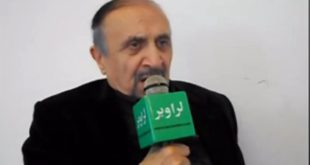Bruce G. Richardson
Discourse and Debate: Configuring the War-Narrative
During a press-conference in 2010, an Obama senior administration official said that the U.S. hasn’t seen a terrorist threat from Afghanistan “for the past seven or eight years.” He also stated, “There is no evidence at all that there is any effort within Afghanistan to use Afghanistan as a launching pad to carry out attacks outside Afghanistan’s borders. There has not been a terrorist threat from Afghanistan for the past seven or eight years.” So, if al-Qaeda is not in Afghanistan and is not a threat to the U.S., what are we doing there? (23, 24)
Recently, in fabricated terms and language during his visit to Afghanistan, President Obama said while addressing the troops “We did not choose this war, the war came to us.” And during a later televised address to the American public he said “This is where the war began and this is where it will end.” These obvious and callous fabrications reflect an attempt to persuade the American public that the president is defending America, was therefore justified in attacking Afghanistan, and must be supported. It is this premeditated and obvious propaganda that incites and fuels the clarion call for violence and has led to the United Nations Resolution banning propaganda as a war crime.
Years ago, as an anti-war candidate, President Obama spoke out against the Iraq War, stating that “This is a wrong war we should not be fighting.” Yet, since becoming president, and we must here assume for reasons of political expediency during his re-election campaign, the president’s exhortations as a hawkish war president have uncontestably extinguished all earlier anti-war sentiments from then candidate Barack Obama. As president, Obama increased U.S. presence in Afghanistan. He has greatly increased the pace of drone missile attacks on targets in Afghanistan, Pakistan, Yemen, Syria and Somalia. He launched an air war against the Government of Libya, which had neither attacked, or threatened us, and seems destined of late to engage Iran in war at the behest of Israel.
The selling of a war to the general public is an exact science. This science, we now understand, often time is termed “framing the narrative,” a more palatable term for propaganda. Framing the narrative likely will manifest in official pronouncements and or sloganeering aided by an ever present, malleable media assistance. Altruistic slogans such as “war on terror, war on drugs and or humanitarian intervention,” will rise as cause celeb for building consensus among an unsuspecting public for war, though the humanitarian aspect is more a rhetorical approach, camouflaging real intent and or policy, and as is so often the case, dwarfed by overwhelming numbers of civilian casualties caught up in the zone of our noble “humanitarian” intervention.
The foregoing reflects a belief, based on many years of study of the workings of the media, and for the purpose of this inquiry, the attendant news coverage of Afghanistan, that they serve to mobilize support for the special interests that dominate the state and private activity, and that their choices, emphases, and omissions can often be understood best, and sometimes with striking clarity and insight, by analyzing them in such terms. Leaders of the media claim that their news choices rest on unbiased professional and objective criteria, and they have the support for this contention in the intellectual community. (1, 22) If, however, the powerful are able to fix the premises of discourse, to decide what the general populace is allowed to hear, and think about, and to manage public opinion by regular propaganda campaigns, the standard view of how the system works is at odds with reality. (2, 22) Walter Lippmann writing in the 1920s claimed that propaganda had already become a “regular organ of popular government,” and was steadily increasing in sophistication and importance. (3, 22) For many people an issue does not exist until it appears in the news media. Indeed, what we even define as an issue or event, what we see and hear, and what we do not see and hear are greatly determined by those who control the world of communications. The mass media serve as a system for communicating messages and symbols to the general populace. It is their function to amuse, entertain, inform and inculcate individuals with the values, beliefs and codes of behavior that will integrate them into the institutionalized- structures of the larger society. (4) In a world of concentrated wealth and major conflicts of class interest, to fulfill this role requires systemic propaganda. (5) A propaganda model focuses on this inequality of wealth and power and its multilevel effects on mass-media interests and choices. It traces the route by which money and power are able to filter out the news they deem fit to print, marginalize dissent, and allow the government and dominant private interests to get their message across to the general public.
The essential ingredients of our propaganda model or set of news “filters” fall under the following headings: The size; concentrated ownership; owner-wealth; and profit orientation of the dominant mass-media firms; advertising as the primary income source of the mass-media; the reliance on information provided by government, business, and “experts” funded and approved by these primary sources and agents of power; coercive measures taken by the power brokers as a means of disciplining the media; “antiterrorism” replacing Communism as a national religion and control mechanism; (6) These elements interact with and reinforce one another. The raw material of news must pass through successive filters. Leaving only the cleansed residue fit to print. Thus, they mold the premise of discourse and interpretation, and the definition of what is newsworthy in the first place, and they therefore explain the basis and operation of what amounts to propaganda campaigns. (7, 22)
The myth of objectivity: As articulated by the journalism profession, “objectivity” means reporters should not render their own opinions or biases into their reporting. But the worthy ideal has been debased in practice to mean that reporters must discard their critical thinking and questioning. They must not press to deeply into areas that might cause discomfort to those of power, wealth and conservative ideology. In so trying to neutralize themselves, they often succeed in neutralizing their subject matter. Corporate and government entities not only own the media but control much of the world’s infrastructure as well, including but not limited to its financial, legal, educational, military and cultural institutions. Thus government and corporate interests not only structure the way the media report reality, they structure much of reality itself. (8) Along with owners and advertisers, government leaders exercise a substantial influence over what becomes news. (9) Aside from this coincidence of ideological perspectives, news people generally are attracted to power, finding it more gratifying and rewarding to stand with than against it. (10) Aware that news people are ready to be seduced, rulers are not above enticing publishers, editors and journalists with invitations into the circles of power. (11, 22)
The government exercises control over news organizations through its control over the product to market: information and (misinformation). Daily assemblages of proposals, tips, press-releases, documents and interviews roll out of the White House and various federal agencies and departments. In a matter of hours, sometimes minutes, the major media are telling the public what the government wants them to hear. (12) The State Department alone spends millions of dollars annually disseminating information that fits its view of the world. It employs a public relations staff of over three thousand people, many of whom can supply snippets to cooperative journalists, or nothing at all to those proscribed as uncooperative. (13, 22) Every morning in the nation’s capital, the White House senior-staff meet to decide as one former participant put it, “What do we want the press to cover today and how? Within minutes after the decisions are made, the “line of the day” is sent out via computer to all senior administration officials and to thousands of government public relations people and press secretaries, covering agencies that deal with both domestic and foreign affairs. (14) As a follow-up, officials call each network fifteen minutes prior to the evening news telecast to ascertain what will appear. (15) As a former chief of staff once remarked about the self-serving stories he repeatedly planted in the press: “We fed it to them and they ate it.” (16, 22)
The Pentagon sends out hundreds of stories and slanted editorials each week that are routinely picked up by newspapers and broadcast stations across the country and presented to the public as trustworthy products of independent journalism. (17) According to former officials at the now-extinct United States Information Service (USIA/USIS), the government has teams of propagandists in Washington who create stories that are wired daily to USIS’s 206 offices in 127 countries. (18) Many of these new plants appear in the foreign press and then return as “blowback,” that is they are picked up by U.S. correspondents abroad and transmitted to an unsuspecting American audience. (19, 22)
The most effective propaganda is that which relies of “framing” rather than on falsehood. By bending the truth rather than breaking it, using emphasis, nuance, innuendo and peripheral embellishments as communicators can create a desired impression without resorting to explicit advocacy and without departing too far from the appearance of objectivity. One common method is to select labels and other vocabulary designers to convey politically loaded images. These labels and phrases, like masks in a Greek drama, convey negative cues regarding events and persona, often without benefit of, and usually a substitute for, supportive information. The persistent, fallacious characterization of all Pashtuns as synonymous with the Taliban, oppressive, and or religious zealots is a case in point. (20, 22)
When political struggles are never explained in their substance, we are left with the presumption that the conflict is caused by an innately hostile adversary. By slighting content and framing details as in news programs such as Sixty Minutes, Fox News, and the Rush Limbaugh show, the media are able to neutralize the truth while giving an appearance of having thoroughly and objectively treated the subject. Misinformation is sometimes so widespread that the line between intentional and unintentional distortion is not always easy to discern, neither for those who transmit the untruth nor for us who try to detect them. (21, 22)
For the continuity of civilization, history and the lessons derived therefrom must be more than propaganda with selective foot notes.
Bruce G. Richardson
Notes:
The Political Economy of the Mass Media, Edward S. Herman, 1988.
Ibid.
Ibid.
Ibid.
Ibid.
Warriors of Disinformation, Alvin A. Snyder, 1995.
Ibid.
Ibid.
Ibid.
Ibid.
The Politics of Lying, David Wise, 1973.
Ibid.
Ibid.
Ibid.
Ibid.
Ibid.
Ibid.
Unreliable Sources, Lee Solomon, 1995
Ibid.
Ibid.
Ibid.
The CIA owns everyone of significance in the major media, William Colby, former CIA Director
Business Insider, To the US, Zeke Miller, 6/22/2011
Foreign Policy, (FP)The Cable, Josh Rogin, 6/22/2011
 لراوبر ویب پاڼه لراوبر يو افغان – تازه خبرونه
لراوبر ویب پاڼه لراوبر يو افغان – تازه خبرونه


